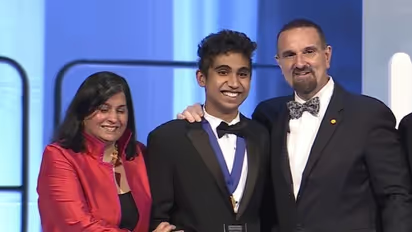Meet Neel Moudgal, the Indian American from Michigan who won the prestigious Regeneron STS award (VIDEO)

Synopsis
Neel, who took home $250,000 prize as part of the award -- also known as the US' Junior Nobel in math and science -- studies at the Saline High School near Detroit.
Indian American Neel Moudgal has won the prestigious Regeneron Science Talent Search award for creating a computer model that can rapidly and reliably predict the structure of RNA molecules using only easily accessible data.
The 17-year-old from Saline, Michigan, believes this model will make it easier to diagnose and treat certain diseases. The Regeneron Science Talent Search award is the oldest and most prestigious science and math competition for high school seniors in the United States.
Neel, who took home $250,000 prize as part of the award -- also known as the US' Junior Nobel in math and science -- studies at the Saline High School near Detroit. He is a programmer for the school robotics team.
Neel was born to Vivek and Varsha Moudgal. According to reports, Neel attributes his love for geology and chemistry to his passion for collecting and studying rocks and minerals. He is also a second-degree black belt in Taekwondo.
Neel's computer model was able to predict RNA structure with over 85 per cent accuracy. Consequently, he was able to demonstrate that the uCS-BME framework is a viable method for RNA structural prediction, both in research and in industry.
According to Neel, it is important to understand the structure of RNA to understand its vital functions. A variety of diseases like cancer, lupus and epilepsy have RNA involved in their pathogenesis, and an understanding of RNA structure will help treat such diseases.
Neel's model is more promising because current approaches to RNA structural prediction are either limited by today's understanding of RNA thermodynamics or require difficult-to-collect data. His project focussed on developing an approach to predict RNA structure using only easy-to-collect experimental data.
Neel believes that his tool can help researchers in academia and industry better understand the function of RNA in various diseases to develop novel diagnostics and therapeutics for these diseases.
Check the Breaking News Today and Latest News from across India and around the world. Stay updated with the latest World News and global developments from politics to economy and current affairs. Get in-depth coverage of China News, Europe News, Pakistan News, and South Asia News, along with top headlines from the UK and US. Follow expert analysis, international trends, and breaking updates from around the globe. Download the Asianet News Official App from the Android Play Store and iPhone App Store for accurate and timely news updates anytime, anywhere.